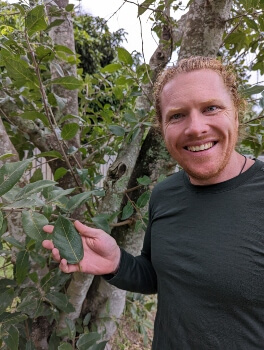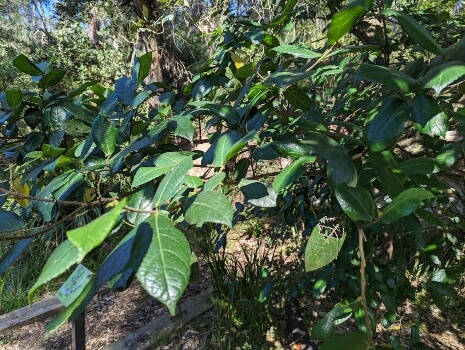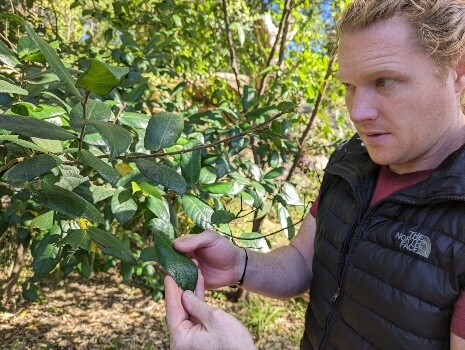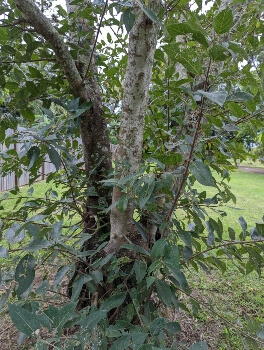There is nothing better than a fig paired with cheese for me, and a chilled glass of wine to finish it off. Perhaps you prefer your figs in a jam or pie, or to eat them straight off the tree. The Sandpaper fig is a real treat to have in any garden.
In our how to grow and use guide, we’ll introduce the Sandpaper Fig, look at how to grow and care for this tree, how to propagate from seed or cutting, and how to eat, prepare and use this delicious fig.
More...

Nathan Schwartz of Aussie Green Thumb holding a Ficus coronata leaf.
Family: | Moraceae |
|---|---|
Genus: | Ficus |
Species: | coronata |
Common Names: | Sandpaper fig, Creek sandpaper fig |
Location: | Indoor or outdoor |
Type: | Tree |
Growth: | Up to 12 metres tall, 6 metres wide |
Sun requirements: | Full sun or part shade |
Foliage Colour: | Green |
Flower Colour: | Red and inside the fruit |
Flowering: | February/March |
Fruit: | Green, purple-black |
Maintenance level: | Average |
Poisonous for pets: | Yes |
Introducing Sandpaper Fig

The Creek sandpaper fig has rough leaves like the name suggests and the Aboriginal people knew how to use this tree to its full potential. The leaves were used to maintain their weapons, they made string from the bark, and of course the fruit was part of their staple diet.
If you were to go foraging in the wild to find the Sandpaper fig, you would find it in the east of Queensland and New South Wales. Sandpaper fig is a ficus tree after all and that means the flowers form on the inside of the fruit. That is why only a specific type of wasp can pollinate the figs.
Guide to Growing Sandpaper Fig
How to Propagate Sandpaper Fig
Propagating Sandpaper Fig from Seeds
If you are planning to propagate your Ficus coronata from seed, you can start off by cutting a fresh fig in half, and once you have removed the pulp and seeds, can soak them for about 2 days. Any seeds that sink are the right ones to plant.
The great thing is that the seeds you are using have absorbed water and will crack open and germinate quite speedily. You can plant your seeds in an appropriate potting mixture – we recommend some peat and perlite.
Once you have watered your mixture, you can mix the seeds with some sand and then sprinkle over the planting mixture. Put the seeds somewhere warm and in a spot that will get enough sunlight – you’re aiming for at least 6 hours per day.
Ficus coronata Propagation from Cuttings
Aim to take a cutting from the end of a creek sandpaper fig branch, and the cutting should be around 30cm. You might want to take a few cuttings and then plant them in some potting soil, making sure at least half the cutting is buried.
Check the soil to see how often you need to water – if it feels dry, you can give it some water. Put the planted cuttings somewhere warm and let the magic happen.
It is also possible to root a Ficus coronata cutting in water. If you’re going this route, just ensure that there is enough water to cover one node on the cutting as a minimum. It’s best to change the water often to help make sure the cuttings don’t rot.
Put the submerged cutting next to a window where it’s sure to get enough light. Cuttings especially don’t need much light to get going.
Caring for Creek Sandpaper Fig

Nathan Schwartz of Aussie Green Thumb examining a Sandpaper fig tree
The Sandpaper fig is hardy. It is used to living in all kinds of natural settings that include rainforest and creeks. This might tell you that it can handle cold weather and below average soil. It does love light, but will adjust accordingly if not readily available.
The Sandpaper fig enjoys lots of space to grow and good moisture, and warmth is the cherry on top. It does not like frost so rather grow it indoors if you’re living somewhere with frosty winters.
Size wise, the Sandpaper fig is usually between 6 and 12 metres in height and can spread out between 3 and 6 metres. Compared to other fig trees, its root system is small but the roots still pack a punch when it comes to strength.
Our recommendation is to grow your Sandpaper fig at least 5 metres away from any plumbing or foundations. The tree is diverse in terms of its uses – it can be a hedge, or a great shade provider.
Sunlight
The creek sandpaper fig needs enough light in order to grow, and anything from full sun to partial shade will do. It’s been said that the more light the tree gets, the sweeter the fruit.
Watering Sandpaper Fig
Your Sandpaper fig needs to be watered regularly and the soil should dry out between each watering session.
Soil
The Sandpaper fig likes well-draining soil. You could always add some organic matter to the soil to help out with drainage, something like perlite or vermiculite is great.
Pruning
The Sandpaper fig can handle heavy pruning and you can prune as needed to maintain shape and size. When you prune your Ficus coronata, you’ll notice that the tree leaks a milky white sap. This sap can cause skin irritation so just be cautious.
What Fertiliser to Use
When choosing a fertiliser for your fig tree, you can opt for one that is designed for fruit trees or an all-purpose fertiliser that has an equal balance of nitrogen, phosphorus and potassium. The nitrogen helps with leaf growth and phosphorus promotes healthy roots, flowers and fruit. You can fertilise your tree twice a year.
Sandpaper Fig as Bush Tucker

The perfect way to enjoy the delicious figs of the Ficus coronata is raw and fresh from the tree, with skin and seeds too. Some people prefer to peel the fruit and scoop out the seeds. If cooked figs is more your taste, you can prepare them through baking or boiling them, and they are also delicious under the grill.
This particular type of fig tree produces an extraordinary tasting fruit that is much loved by Australians. The fruit is small, only about 2 cm, and begins as a green colour. As the fruit starts to ripen, the colour changes to a purple-black.
You can enjoy the fruit dried, or use it for cooking up all sorts of yummy things. The Sandpaper fig has many culinary uses and is used in everything from cakes and biscuits to sauces and jams.
The creeping fig or Ficus pumila is another great option for your garden. Have a read through our guide on this to learn more.
Pests and Disease that Affect Sandpaper Fig

Queensland fruit fly (Dacus tryoni)
This fruit fly is a pesky nuisance in many parts of NSW. The flies are small and either brown or black in colour with yellow marks. The female fly lays eggs in the fig fruit which causes it to rot.
Fig blister mite (Aceria ficus)
These mites either have no colour or are white in appearance. They leave dry patches that look like rust on the fig fruit.
Fig rust and Anthracnose
These are fungal diseases that are more prevalent on the coast. With fig rust you would see yellow spots that look like powder on the leaves, and with anthracnose, it forms brown or black spots that start small but eventually become bigger.
You’ll notice that the Ficus coronata leaves start to become yellow and will fall off.
Fig mosaic virus
Fig mosaic virus attacks the leaf pigment in your Sandpaper fig. It creates a mottled looking pattern on your fig tree leaves.
We like to advocate for natural pest control wherever possible – showing the environment some love is always top priority when it comes to gardening. Check out our advice on the best natural and organic pest control for your garden.
Want to know more about native Australian plants and how to care for them? Sign up for our newsletter and get plenty of tips, and green reading material.
Wrapping Up Our Sandpaper Fig Guide
Ficus coronata is a delightful garden companion – enjoy delicious fruit, and nurture a tree that is bound to bring you much joy. You can propagate this tree easily, it doesn’t need large amounts of care, and is good looking in any garden setting. I’m giving the Sandpaper fig my green thumbs up!
Published on November 25, 2022 by Nathan Schwartz
Last Updated on February 22, 2024




